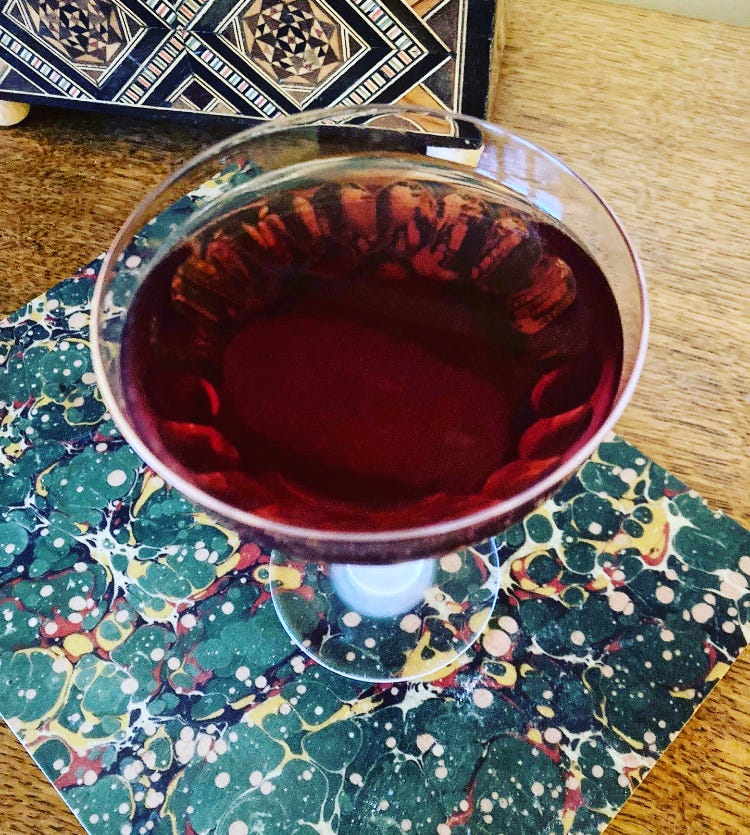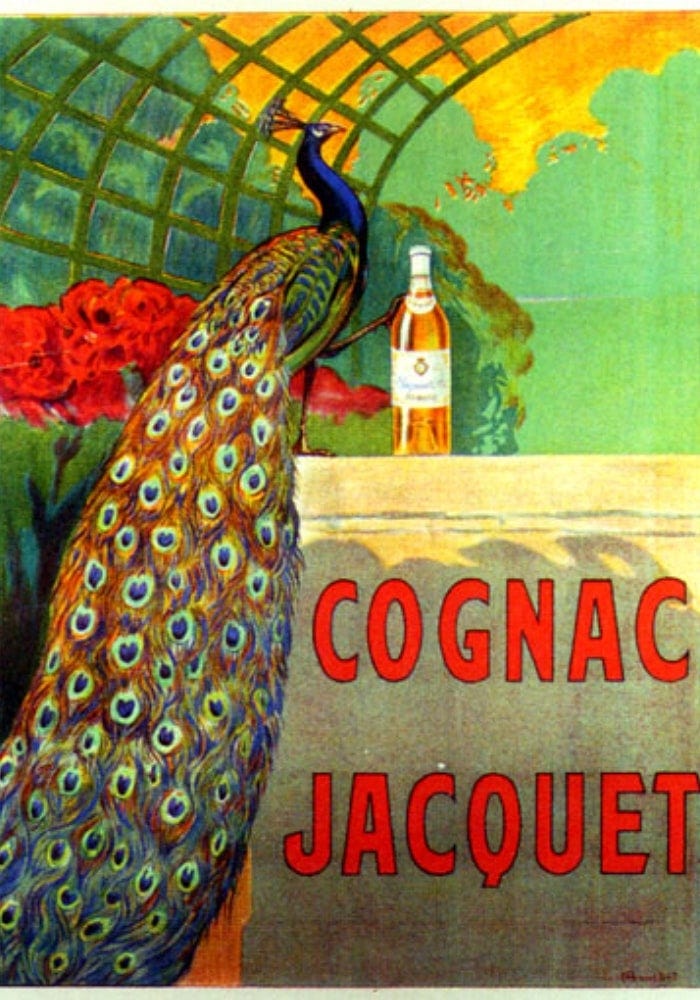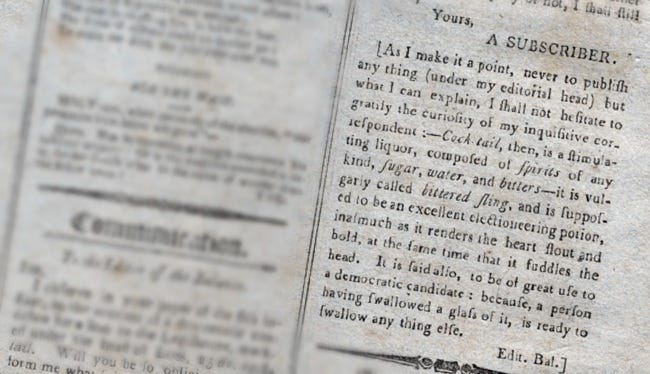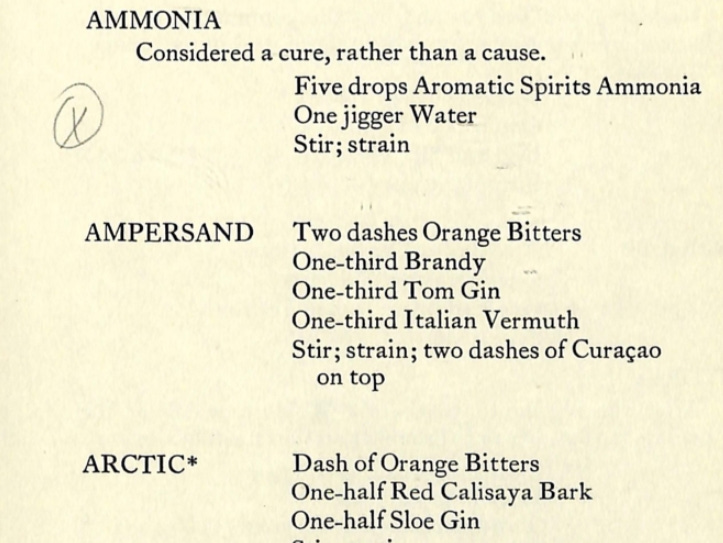The Spirits #68: The Ampersand
~ World Cocktail Day ~ Free Lunch ~ X. Y. Z. &. ~ Duets ~ Goldie's Abandoned Mine ~
~ THE AMPERSAND ~
25ml brandy
25ml gin
25ml Italian vermouth
10ml orange liqueur
Dash Angostura bitters
Stir everything with plenty of ice and strain into a cold coupe. Lemon zest twist!
Some Ampersand Notes:
1) The original specifies orange bitters, not Angostura bitters. I don’t know why, I just find orange bitters kind of disgusting and regret it every time I use it in a cocktail. You may feel differently.
2) The original also specifies Old Tom gin, a sweeter and slightly more licoricey style of gin popular in the 19th century. But don’t sweat it.
3) Avid readers of my book the Spirits will, have tried my rather good variant on this in which the brandy is switched for pisco. This remains one of my favourite drinks but sadly I’m fresh out of pisco.
YOU AGAIN! 🥳
🖊️I am Richard Godwin.
🧋My instructions for sugar syrup, ice, grenadine etc are here.
🧑🏫 My 10 RULES FOR MAKING COCKTAILS are here.
⚗️ My bottle recommendations are here.
📃 The full A-Z recipe archive is here.
➡️ Please find a round up of organisations helping Ukrainians here.
And you like The Spirits, do please forward this to all of your friends.
IMAGINE my surprise when I learned that today is World Cocktail Day. Every day is World Cocktail Day in my house! Although it would be nice if all World Cocktail Days unfurled in the warm afterglow of Tottenham 3-0 Arsenal with a new Radiohead(ish) album and a new Kendrick Lamar album to explore and a nice blue sky too. Oh well, even more reason to celebrate.
I am not usually a strict observer of these made-up occasions - Negroni Week, Advocaat Awareness Month, etc - though I do make an exception for International Kümmel Day, 17th April, but that’s only because Henry Jeffreys, Simon Difford and I made that one up). Nevertheless World Cocktail Day has more legitimacy than most. It marks the day in 1806 when the first definition of “cocktail” appeared in print, in response to a reader’s letter to The Balance and Columbian Repository, a New York state political pamphlet:
“Cock-tail, then, is a stimulating liquor, composed of spirits of any kind, sugar, water, and bitters.”
So there you go. Note the little joke about the Democratf. If I had any kind of forefight, I would have fet before you an 1806-ftyle “cocktail” complete w/ early-19th century typography! But I have none and fo here inftead is the Amperfand.
Ahem.
The Ampersand is from the classic Old Waldorf Bar Days (1931), written by the New York journalist and press agent, Albert Stevens Crockett. The book is a paean to the great Waldorf Astoria hotel in New York (home of the Waldorf Salad) and the drinks that were invented behind the famous “brass rail” bar before Prohibition, which was still raging when the book was first published.
A tone of nostalgia permeates: “Some of us like occasionally to dwell on the past, to recall simpler days when nothing was complex and there were no talk of ‘complexes’” writes Crockett in his foreword. He had frequented the bar since 1897 and, since the Waldorf was a favoured hangout of Wall Street types, he could source most of his stories from the bar. The Waldorf also laid on a free lunch for all patrons, he tells us. It wasn’t just cheese sandwiches and Twiglets either: “There are many rich men in this land to-day who, were they frank, could date their first acquaintance with Russian caviar to that generous board,” Crockett writes. You can see why he pined for the bar as it was.
On a long-ago trip to New York, I actually stayed at the Waldorf-Astoria which is, indeed, not what it was. But I did sink quite a few cocktails with the then bartender Frank Caiafa, who was hard at work on his own Waldorf Astoria Bar Book, a loving trawl through the archives. The Ampersand, he considers to be “one for the ages”:
“What struck me most when I came across the original formula was how modern it looked right from first glance. The combination of ingredients could easily be imagined on the menus of any number of today’s most famous cocktail bars and discerning restaurants, though it had its heyday at the end of the 19th century. Its unique use of two base spirits (brandy and gin —another use for an ampersand) makes for quite the offering.”
Frank has his preferred spirits (Copper & King American Brandy; Ransom Old Tom Gin, Martin & Rosso Vermouth, Pierre Ferrand Dry Curacao) but his only real tweak was to incorporate the curacao in the build of the drink rather than pouring it on top. Frank is now at Handle’s Bar if you’re drinking in NYC anytime soon. Order one of these and tell him I said hi.
As for the name Ampersand, theories abound, but I like the one advanced by the linguistic historian Nancy Upper in her book about the ampersand symbol. Apparently, from the 17th century to the mid-20th, the ampersand - & - was taught to children as the 27th letter of the alphabet. Who knew? Not me. She believes that Charles M. Adams’ book, The Ampersand in Schoolroom Song and Barroom (1936) offers the “true source” of the drink’s name:
“The gallant gentlemen of the older school who used to gather round the bar of the old Waldorf-Astoria were not forgetful of the services of this last but not least of the letters in the alphabet. They tipped their glasses to its memory with a faithfulness that would have done credit to their first teachers. After having used every letter at their command, quietly recalling past memories, they would order an Ampersand and as gentlemen raise their glasses in a toast: “& goa ta bed.”
I love the idea of & being the last letter of the alphabet. X, Y, Z, &. It encodes the subtle but important message that no endings are ever quite final. &
PLAYLIST
Ella & Louis, Lee & Nancy, Serge & Jane, Marvin & Tammy, Thom & Polly. Yes, it’s duet week! A fitting tribute to the &, I thought. And much like hotel lunch buffets, I can’t help thinking that they don’t do duets as they used to.
THIS PLAYLIST UPDATES AUTOMATICALLY EACH WEEK. The idea is, you download it and return to it each week in your Spotify. If there was an old song you’d like to hear again, you’ll find it RIGHT HERE in the ongoing archive of 2021 playlists.
WHAT I’VE BEEN WRITING
I interviewed drum’n’bass legend Goldie who was extremely forthcoming about, well, pretty much everything: drugs, death, trauma, euphoria, the afterlife… Fun fact: Goldie was actually the first act I ever saw live - as he supported Björk (my first true love) on her Post tour in 1995. And I was particularly interested to learn that Björk introduced him to Henryk Górecki’s Symphony of Sorrowful Songs at the time, which would be the main influence on his difficult second album Saturnz Return. Those three discs: Post, Timeless, Górecki… I can just see them cued up on the old-school CD changer I had back then. (ES Magazine)
WHAT I’VE BEEN READING
An optimist’s guide to the future (Guardian)
Universal basic income for artists? Into it. (Financial Times)
Congratulations to aforementioned Henry Jeffreys, an old campadre of mine from my breakfast-writing days, who won the Fortnum & Mason award for his highly enjoyable (Henry’s World of Booze)
SHOPPING LIST
Light rum, Campari, lime, passion fruit, honey.
🍹









Coolio!